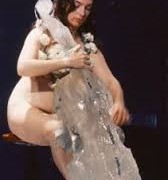We’re quite excited, for purely aesthetic and intellectual reasons, about the forthcoming publication, due in mid October:

Charlotte Moorman was a prominent ornament of the John Cage/Nam June Paik avant-garde, who popped up naked on many stages. Since her death of breast cancer in 1993 she has vanished into the mists of legend. This book, with an intro by her roommate Yoko Ono, should ste things straight. Publisher’s blurb below (you can understand why they blurred the jacket). We’ve asked for an advance copy.

Overview
The Juilliard-trained cellist Charlotte Moorman sat nude behind a cello of carved ice, performed while dangling from helium-filled balloons, and deployed an array of instruments on The Mike Douglas Showthat included her cello, a whistle, a cap gun, a gong, and a belch. She did a striptease while playing Bach in Nam June Paik’s Sonata for Adults Only. In the 1960s, Moorman (1933–1991) became famous for her madcap (and often unclothed) performance antics; less famous but more significant is Moorman’s transformative influence on contemporary performance practice–and her dedication to the idea that avant-garde art should reach the widest possible audience. In Topless Cellist, the first book to explore Moorman’s life and work, Joan Rothfuss rediscovers, and recovers, the legacy of an extraordinary American artist.
Moorman’s arrest in 1967 for performing topless made her a water-cooler conversation-starter, but before her tabloid fame she was a star of the avant-garde performance circuit, with a repertoire of pieces by, among others, Yoko Ono, Joseph Beuys, John Cage, and Paik, her main artistic partner. Moorman invented a new mode of performance that combined classical rigor, jazz improvisation, and avant-garde experiment—informed by intuition, daring, and love of spectacle. Moorman’s annual festival of the avant-garde offered the public a lively sampler of contemporary art in performance, music, dance, poetry, film, and other media.
Rothfuss chronicles Moorman’s life from her youth in Little Rock, Arkansas (where she was “Miss City Beautiful” of 1952) through her career in New York’s avant-garde to her death from breast cancer in 1991. (Typically, she approached her treatment as if it were a performance.) Deeply researched and profusely illustrated, Topless Cellist offers a fascinating, sometimes heartbreaking, often hilarious story of an artist whose importance was more than the sum of her performances.

